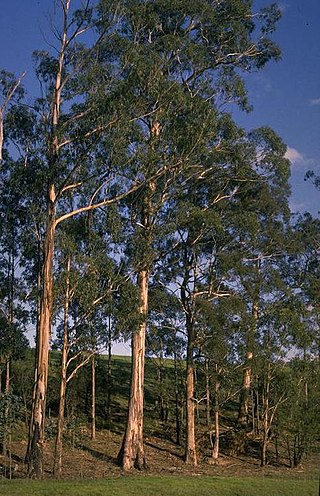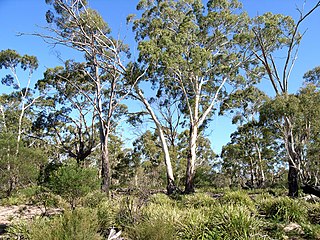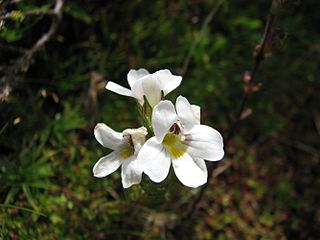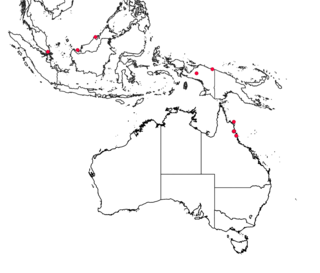
Hakea is a genus of about 150 species of plants in the Family Proteaceae, endemic to Australia. They are shrubs or small trees with leaves that are sometimes flat, otherwise circular in cross section in which case they are sometimes divided. The flowers are usually arranged in groups in leaf axils and resemble those of other genera, especially Grevillea. Hakeas have woody fruit which distinguishes them from grevilleas which have non-woody fruit which release the seeds as they mature. Hakeas are found in every state of Australia with the highest species diversity being found in the south west of Western Australia.

Eucalyptus globulus, commonly known as southern blue gum or blue gum, is a species of flowering plant in the family Myrtaceae. It is a tall, evergreen tree endemic to southeastern Australia. This Eucalyptus species has mostly smooth bark, juvenile leaves that are whitish and waxy on the lower surface, glossy green, lance-shaped adult leaves, glaucous, ribbed flower buds arranged singly or in groups of three or seven in leaf axils, white flowers and woody fruit.

Euphrasia, or eyebright, is a genus of about 450 species of herbaceous flowering plants in the family Orobanchaceae, with a cosmopolitan distribution. They are hemiparasitic on grasses and other plants. The common name refers to the plant's use in treating eye infections.

Eucalyptus viminalis, commonly known as the manna gum, white gum or ribbon gum, is a species of small to very tall tree that is endemic to south-eastern Australia. It has smooth bark, sometimes with rough bark near the base, lance-shaped to curved adult leaves, flower buds in groups of three or seven, white flowers and cup-shaped or hemispherical fruit.

Hakea petiolaris, commonly known as the sea-urchin hakea, is a shrub or small tree with cream-coloured and pink or purple flowers and woody fruit. It is endemic to the south west of Australia, occurring at the coastal plain, jarrah forest and wheatbelt regions, often at the ancient granite outcrops of Western Australia.

Banksia nivea, commonly known as honeypot dryandra, is a species of rounded shrub that is endemic to Western Australia. The Noongar peoples know the plant as bulgalla. It has linear, pinnatipartite leaves with triangular lobes, heads of cream-coloured and orange or red flowers and glabrous, egg-shaped follicles.

Euphrasia arguta is a plant from the genus Euphrasia (eyebrights) within the family Orobanchaceae.

Eremophila oldfieldii, commonly known as pixie bush, is a flowering plant in the figwort family, Scrophulariaceae and is endemic to Western Australia. It is a shrub or small tree with rough bark, broad, flat or narrow fleshy leaves and red, orange or yellow flowers.

Leptecophylla juniperina is a species of flowering plant in the family Ericaceae. The species is native to New Zealand and the Australian states of Tasmania and Victoria. The plant's fruit is edible, raw or cooked. Plants grow best in areas with moderate winters and cool moist summers.

Hakea decurrens, commonly known as bushy needlewood, is a species of shrub or small tree in the family Proteaceae.

Euphrasia collina is a perennial herb or subshrub in the genus Euphrasia. Plants grow to between 5 and 60 cm high and have leaves with 1 to 6 teeth per side. The flowers may be white, blue, pink or purple, sometimes blotched with yellow on the lower petal.

Euphrasia gibbsiae is a perennial herbaceous plant in the genus Euphrasia. It is native to Victoria and Tasmania in Australia. Species in this genus may be called eyebright.

Rostellularia adscendens is an Australian plant species in the family Acanthaceae. It grows to between 10 and 50 cm high.

Euphrasia lasianthera, commonly known as hairy eyebright, is a perennial herb species in the family Orobanchaceae. It is endemic to Victoria, Australia. Plants grow to 30 cm high and have leaves with margins that may be smooth or toothed. The flowers may be white, pink or pale purple. The species was first formerly described by botanist W.R. Barker in Journal of the Adelaide Botanic Gardens in 1982. It is listed as "Rare" on the Department of Sustainability and Environment's Advisory List of Rare Or Threatened Plants In Victoria.

Grevillea refracta, commonly known as silver-leaf grevillea, is a species of plant in the protea family and is native to northern Australia. It is a tree or shrub usually with pinnatipartite leaves and red and yellow flowers arranged on a branched, downcurved raceme.

Eremophila forrestii, commonly known as Wilcox bush is a flowering plant in the figwort family, Scrophulariaceae and is endemic to Australia. It is a many-branched shrub with its branches, leaves and sepals densely-covered with a thick layer of greyish or yellowish hairs giving the plant a felty appearance. Its flowers are cream-coloured to pink and are spotted or streaked dark red. It occurs mostly in Western Australia but also in the far west of South Australia and the Northern Territory. Six subspecies are recognised by the Western Australian Government Department of Parks and Wildlife.

Hakea stenophylla is a shrub or tree in the family Proteacea, with sweetly scented creamy-white flowers. It is endemic to Western Australia.

Grevillea pauciflora, commonly known as the few-flowered grevillea, or as Port Lincoln grevillea in South Australia, is a species of flowering plant in the family Proteaceae and is endemic to the south of continental Australia. It is an erect to straggly or spreading shrub with linear to narrowly wedge-shaped leaves and red or orange flowers with a red or orange style.
William (Bill) Robert Barker is an Honorary Research Associate of the State Herbarium of South Australia.

Leucopogon malayanus is a plant in the family Ericaceae native to Cambodia, Malaya, Myanmar, Thailand, and Vietnam. However occurrence data from GBIF, shows it occurring in Queensland (Australia), Indonesia, Malaysia, Singapore, Brunei and India. It was first described by William Jack in 1820, who "found (it) abundantly at Singapore".


















